In case of insufficient natural air circulation in premises - residential, technical, economic - fans are installed. The devices provide air exchange at the level necessary for the operation of the equipment or creating a comfortable stay. The devices operate in different modes, since the requirements for air exchange change during the day. You can increase or decrease the fan speed using the speed controller.
Changing the rotation speed
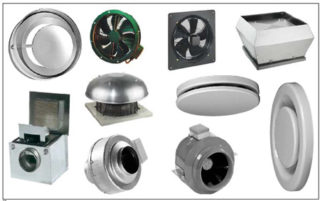
The fan in general is a rotor with blades fixed in a certain way. As the blades rotate, they collide with air and throw it in a certain direction. By design, they are distinguished:
- Axial - the direction of the pumped and sucked breath is the same. The fan is designed to cool something: coolers in computers, household appliances, mine fans, smoke extractors.
- Radial - centrifugal. Air is sucked in from one side of the fan, blown in on the other side - at a right angle. Radial fans are used in industry.
- Tangential - has a complex structure like a "squirrel wheel". Air is drawn in along the periphery and blown in at right angles. This design is used in air conditioners, air curtains, refrigerators.
- Bladeless is essentially an air blower. Almost never occurs in everyday life.
Any fan, due to the specifics of the design, works at full power. This leads to rapid wear of the device and breakdowns. The maximum air flow is not required all the time. To reduce the fan speed, you need to connect a special device.
Fan speed reduction element
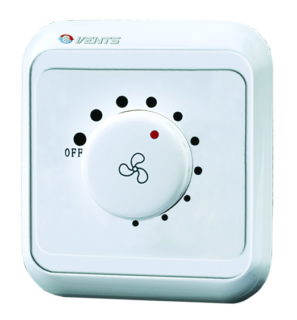
The speed controller adjusts the rotation speed. It can decrease by 2 mechanisms:
- change in the frequency of the current - the lower it is, the less number of revolutions the cooler makes;
- change in voltage applied to the winding.
In the vast majority of cases, type 2 devices are used. Frequency changers usually cost much more than a fan.
Controllers can be mechanical or automatic. The former are manually adjusted using a wheel. You can decrease it both smoothly and stepwise - it depends on the type of device, most often these are triac models. In complex systems, controllers with automatic control are installed. Here, a signal to reduce the number of revolutions is the indicators of sensors: temperature, humidity, gas, photo sensors. Their main goal is to reduce energy consumption when the system is operating at its optimal level and does not need additional cooling.
Reducing the speed of the exhaust fan
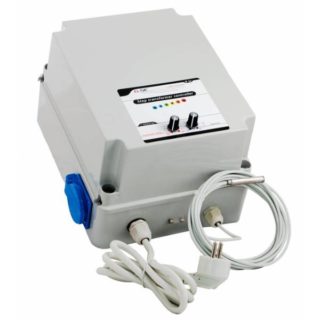
In forced air conditioning systems, duct fans are usually installed. At maximum power, the devices work only in harsh conditions - in an industrial workshop. In company offices, commercial premises and even in laboratories, the hood power varies depending on the time of day and the nature of the activity.
To reduce the speed of the duct fan, a step controller must be installed. The regulator reduces the voltage applied to the winding. In this case, the speed of rotation of the blades also decreases. The transformer step controller is optimal when the rotational speed of the cooler is more convenient to adjust manually, for example, to reduce noise for a while.
If the cooler speed depends on the temperature or humidity level, an electronic module with automatic control is installed.
Automatic controllers are often equipped with alarm indicators, alarm lamps and even the possibility of galvanic isolation from the mains.
Purpose of the controller
Cooler rotation controllers perform several tasks:
- Energy saving - at maximum power, the fan consumes the maximum amount of electricity. It is not profitable. The ability to reduce the number of revolutions when not needed can help reduce your electricity bills.
- Extend Equipment Life - Fan includes moving parts. With intensive work, they quickly wear out and fail. By reducing the number of revolutions, you can increase the service life of the hood, air conditioner, refrigerator.
- Reduced noise level - the fan at maximum power produces relatively little noise. But if there are several devices, the noise level exceeds the tolerable 50 dB. If you lower the speed, the noise will also decrease.
- Constant mode support - without a controller, the fan can only be in 2 states: running at full power and off. When working in a ventilation system, the device periodically turns on and off. This mode leads to overheating of the device and excessive consumption of electricity. The controller provides an inversion principle of operation: a decrease and an increase in the number of revolutions without voltage surges.
The controller can be installed on kitchen exhaust or office ventilation systems, as well as on household appliances and equipment: refrigerators, computers.
Main varieties
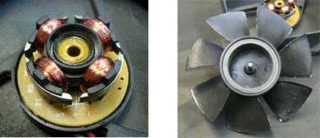
To reduce or increase the fan speed, you need to select a device of the required design. There are several types of controllers. The most famous classification is based on the principle of management. However, they all relate to devices that change the voltage across the winding.
Thyristor or triac
Designed to work with single-phase devices with overheating protection. The principle of phase control is implemented here. 2 thyristors connected in anti-parallel form form a triac. When the voltage passes through zero, the thyristor "cuts off" a part at the beginning or at the end of the voltage wave, depending on the control circuit. As a result, the rms voltage changes.
Thyristor controllers are efficient, compact and produce little noise. However, they can only be connected to electric motors designed with this in mind.
At a network frequency of 50 Hz, triac controllers operate worse: jerks and noise are heard during operation.
Frequency
Change the frequency of the voltage supplied to the fan. With their help, voltage is obtained from 0 to 480 V. Frequency controllers are the main method of regulation in inverter devices: air conditioners, converters. However, the regulator can only work with three-phase electric motors, which limits its use.
Transformer
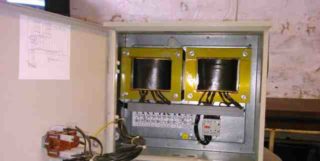
The models are designed to provide the most powerful fans. Produce one- and three-phase devices. Most often these are step regulators. They increase and decrease the voltage at a certain interval, which is indicated in the marking. However, there are options that provide smooth adjustment.
Transformer regulators are bulky and inexpensive.The device can be mounted on walls, inside walls, right inside the unit. The controller can handle multiple fans and is highly reliable.
Device connection rules
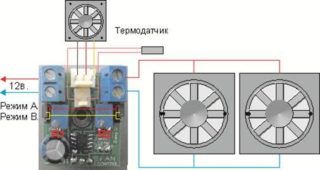
The regulator to reduce the fan speed can be installed and adjusted by a specialist. In simple cases, they cope with this task on their own.
The installation methods of the controllers depend on the type of device: wall-mounted, in-wall version, model for installation inside the case, reobass for adjusting the rotation of coolers in the system unit, etc. The regulator connection diagram is available in the instructions for the device. After reading the manual, you can figure out how to connect and maintain the appliance.
- Wall and in-wall options are fixed to the wall with screws or dowels. Fasteners are usually included.
- The regulator is connected to the power cable according to the diagram provided by the manufacturer. The task comes down to cutting the zero, phase and ground wires and connecting the conductors in series to the input and output terminals.
- Before starting the installation, make sure that the cross-section of the connecting power cable corresponds to the maximum current of the controller to be connected.
- If the fan has its own switch. The latter must be dismantled and replaced with a controller.
To reduce the speed of a computer cooler, they use an additional resistance device or its improved version - reobass. The preliminary work is more difficult here. It is necessary to correctly assess what is the permissible temperature for each piece of equipment: motherboard, graphics card processor. Otherwise, a decrease in the cooler speed leads to overheating and damage to the processor or board.
The principle of connecting the reobass: the wires from the fan are cut off and connected to the regulator according to the scheme specified by the manufacturer. Reobass is more convenient in that it controls several fans at once, while additional resistance reduces the speed of only 1 device.
Do-it-yourself assembly
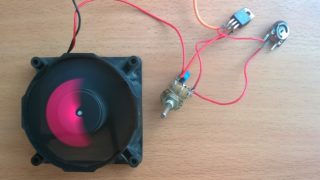
The controller is a resistance connected according to a specific circuit. You can assemble the simplest option for controlling a household fan with your own hands. You will need 3 parts for this: variable and constant resistors and a transistor.
- The base of the transistor is soldered to the center contact of the variable resistor. A collector is connected to the extreme terminal of the resistor.
- A fixed resistor with a resistance of 1 kOhm is attached to the other end of the resistor by soldering. The second terminal of the constant resistor is soldered to the emitter of the transistor.
- An input voltage cable is attached to the transistor collector, and the positive output is fixed to the transistor emitter.
- To check the operation of the element, the wire from the emitter is connected to the "positive" wire of the fan. The output voltage wire from the homemade reboas is connected to the power supply. The "negative" fan wire is attached directly, not including the regulator in the circuit.
- Plug the power supply into the network. Decrease and increase the rotational speed of the cooler by turning the wheel of the variable resistor.
The homemade product is completely safe for the fan, since the negative wire is connected directly. Even if the controller closes, the cooler will not be damaged.








